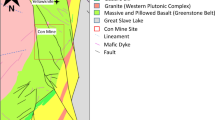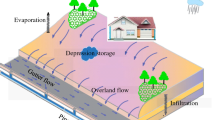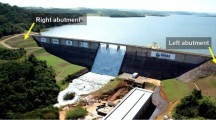Abstract
This paper presents a study of the spatial distribution of pore water pressure on urban tunnels in water-rich regions. Based on Harr’s classical solution for unlined tunnels and the actual hydrological environment, a water pressure formula of the seepage field is derived by regarding the surrounding rock, grouting circle, lining, etc., as a complete system. The seepage model test system developed is applied to test the distribution of water pressure in the surrounding rock for an unlined tunnel and a tunnel that contains both a grouting circle and a lining. For the unlined tunnel, the degree of coincidence between the theoretical and experimental results is higher at a distance from the tunnel center than near the center of tunnel. For the tunnel with the grouting circle and lining, the theoretical solution tallies with the experimental results. The decrease in the permeability coefficient of the grouting circle or the degradation of lining permeability will cause the water pressure in the surrounding rock to rise, with the latter effect being more significant. However, the effect of changing the grouting radius on the tunnel seepage field is not obvious.














Similar content being viewed by others
References
Arjnoi P, Jeong JH, Kim CY, Park KH (2009) Effect of drainage conditions on porewater pressure distributions and lining stresses in drained tunnels. Tunn Undergr Sp Technol 24(4):376–389
Bagnoli P, Bonfanti M, Della Vecchia G, Lualdi M, Sgambi L (2015) A method to estimate concrete hydraulic conductivity of underground tunnel to assess lining degradation. Tunn Undergr Sp Technol 50:415–423
Chen YS (1977) Single Well Hydraulics. China Architecture & Building Press, Beijing
Fernández G, Alvarez TA Jr (1994) Seepage-induced effective stresses and water pressures around pressure tunnels. J Geotech Eng 120(1):108–128
Fernandez G, Moon J (2010) Excavation-induced hydraulic conductivity reduction around a tunnel–Part 1: Guideline for estimate of ground water inflow rate. Tunn Undergr Sp Technol 25(5):560–566
Gao X, Qiu W, Kong C (2013) Test study on the variation law of seepage field during the construction process of high water pressure tunnel. China Railw Sci 34(1):50–58
Gattinoni P, Pizzarotti EM, Scesi L (2016) Geomechanical characterisation of fault rocks in tunnelling: The Brenner Base Tunnel (Northern Italy). Tunn Undergr Sp Technol 51:250–257
Goodman RE, Moye DG, Van Schalkwyk A, Javandel I (1964) Ground water inflows during tunnel driving. College of Engineering. University of California, Berkeley
Harr ME (1962) Groundwater and Seepage. McGraw-Hill, New York City
He C, Wang B (2013) Research progress and development trends of highway tunnels in China. J Mod Transp 21(4):209–223
Huang T, Lizhong Y (1999) A prediction study of water-gush yield in fractured tunnels under coupling between seepage and stress. J China Railw Soc 21(6):75–80
Huang Y, Fu Z, Chen J, Zhou Z, Wang J (2015) The external water pressure on a deep buried tunnel in fractured rock. Tunn Undergr Sp Technol 48:58–66
Jianxiu W, Hehua Z, Weimin Y (2004) Forward and inverse analyses of water flow into tunnels. Chin J Rock Mech Eng 7:023
Kahn KG, Ge S, Caine JS, Manning A (2008) Characterization of the shallow groundwater system in an alpine watershed: Handcart Gulch, Colorado. USA Hydrogeol J 16(1):103–121
Li D, Li X, Li CC, Huang B, Gong F, Zhang W (2009) Case studies of groundwater flow into tunnels and an innovative water-gathering system for water drainage. Tunn Undergr Sp Technol 24(3):260–268
Li PF, Zhang DL, Zhao Y, Zhang CP (2012) Study of distribution law of water pressure acting on composite lining and reasonable parameters of grouting. Chin J Rock Mech Eng 31(2):280–288
Li Z, Wang B, He C, Wang JY, Cheng TJ (2015) Suitable construction method for urban shallow tunnel crossing through complex stratum in saturated sandy soil. China Railw Sci 36(1):75–82
Liu JG (2014) Research on tunnel drainage control based on ecological environment protection. Mod Tunn Technol 51(3):61–66
Liu Q, Tan ZS, Wang XY (2015) Model test study on the distribution law of underwater tunnel seepage field. China Civ Eng J 48(S1):388–392
Liu XR, Shi JX, Liu YF, Fang T, Ou MX (2013) Study on tunnel model test of water disasters. China J Highw Transp 26(1):121–126
Meriano M, Eyles N (2003) Groundwater flow through Pleistocene glacial deposits in the rapidly urbanizing Rouge River–Highland Creek watershed, City of Scarborough, southern Ontario, Canada. Hydrogeol J 11(2):288–303
Perazzelli P, Leone T, Anagnostou G (2014) Tunnel face stability under seepage flow conditions. Tunn Undergr Sp Technol 43:459–469
Tan ZS, Zen C, Li J, Du CW, Zhang P (2011) Model test investigation on the mechanical characteristics of support structure of subsea tunnels. China Civ Eng J 44(11):99–105
Wang X, Wang M, Zhang M, Ming H (2008) Theoretical and experimental study of external water pressure on tunnel lining in controlled drainage under high water level. Tunn Undergr Sp Technol 23(5):552–560
Wang JY (2003) Once more on hydraulic pressure upon lining. Mod Tunn Technol 3:5–8
Zhang MY, Jing SR, Li GJ (2006) Advanced Engineering Hydrodynamics. Xi’An Jiaotong University Press, Xi’An
Acknowledgments
This research was financially supported by the National Key R&D Program of China (Nos. 2016YFC0802201 and 2016YFC0802210) and Doctoral Innovation Fund Program of Southwest Jiaotong University.
Author information
Authors and Affiliations
Corresponding author
Rights and permissions
About this article
Cite this article
Li, Z., He, C., Chen, Z. et al. Study of seepage field distribution and its influence on urban tunnels in water-rich regions. Bull Eng Geol Environ 78, 4035–4045 (2019). https://doi.org/10.1007/s10064-018-1417-0
Received:
Accepted:
Published:
Issue Date:
DOI: https://doi.org/10.1007/s10064-018-1417-0




